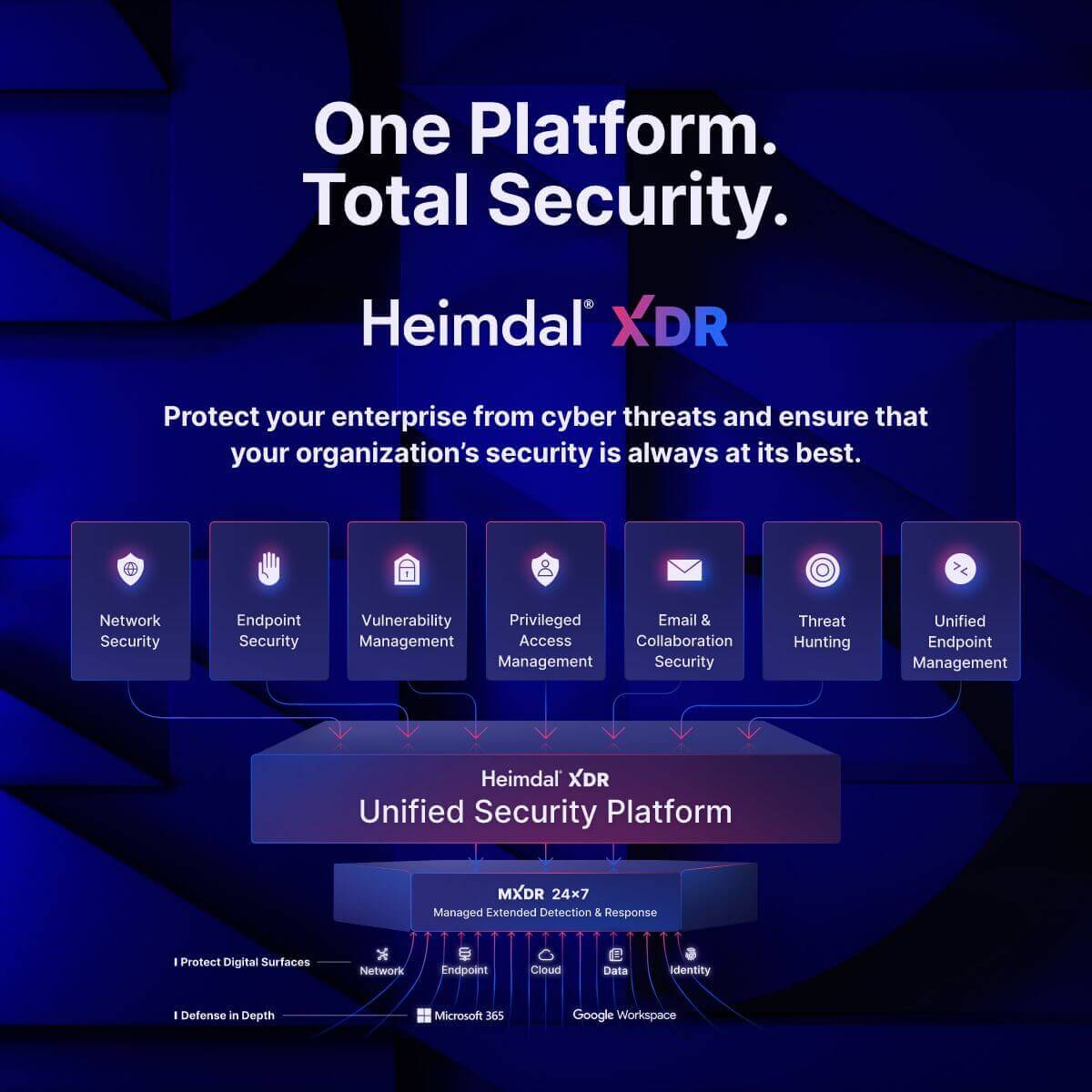Contents:
Although it’s one of the most appreciated solutions, users constantly ask for NinjaOne alternatives on social channels. Choosing the right IT management software is one of the most important decisions you make as a CIO or CISO, so give it your full attention.
According to review sites, NinjaOne customers are switching to alternatives mainly because of a poor user experience, slow customer support, complex configuration, and a non-scalable RMM pricing structure.
The support has been lack-luster. They haven’t been timely with responses, and I had a hard time understanding a couple of the reps I had Zoom calls with. The agent is also not installing well.
said one recent Gartner review.
For those who feel like trying something else, here are 10 top NinjaOne alternatives to explore. In this research, I focused on NinjaOne competitors’ main features and took a quick peek at what people say on review platforms. This should help you make an informed decision and find the best solution for your needs.
The 10 Best NinjaOne Alternatives
1. Heimdal® XDR
Heimdal® XDR, one of the best NinjaOne alternatives, offers tailored security solutions for enterprises, especially IT teams, focusing on precise monitoring and rapid response across endpoints, networks, emails, identities, and data.
By supporting clients using Microsoft 365 or Google Workspace, Heimdal® XDR and MXDR services provide comprehensive security coverage. The MXDR team ensures proactive threat detection, incident response, and vulnerability management while reducing operational costs. Key services include continuous security monitoring, proactive threat hunting, and 24/7 client support.
Advanced tools like custom dashboards, Heimdal® Next-Gen AntiVirus, and ransomware protection are used for effective security management.
With a strong focus on cybersecurity expertise, rigorous incident response processes, and adherence to data privacy policies, the MXDR team ensures clients’ digital environments remain secure and compliant.
Features:
- Integrated Threat Hunting: Heimdal® XDR equips security teams with pre-calculated risk scores, indicators, and detailed attack analyses. This enables immediate responses to potential threats, enhancing overall threat management effectiveness.
- Real-Time Threat Hunting and Response: Heimdal® XDR empowers security and IT teams with advanced threat intelligence, bi-directional telemetry, and detailed forensic insights. Leveraging AI/ML predictive models and the Extended Threat Protection (XTP) detection engine, it utilizes MITRE ATT&CK techniques to swiftly detect and counter threats.
- Automated Remediation and Response: Heimdal® XDR’s Action Center facilitates seamless one-click automated and assisted responses, ensuring swift and effective threat mitigation across digital environments. This feature safeguards business operations and data through efficient threat response capabilities.
- Intelligent Insights for Enhanced Operations: Heimdal® XDR delivers precise heuristics with minimal false positives, providing fully contextualized data for threat hunting, investigations, audit trails, and reporting. Pre-scored information ensures accurate and actionable security operations.
Pros:
- Heimdal® simplifies MSP operations with comprehensive patch management for multiple clients.
- Automated asset management saves time and reduces manual effort.
- Rollback option for OS updates prevents downtime caused by incompatible or faulty patches
- Enhances security and trust by ensuring compliance with industry regulations.
- Customizable scheduling minimizes client disruptions.
- Supports a wide range of third-party applications for thorough protection.
- Automated patching, with updates delivered within roughly 4 hours, maintains system security.
- Seamless enforcement of patching policies across all client systems.
- Infinity Management add-on further automates client-specific applications.
- Unified endpoint management due to the unified XDR dashboard and user-friendly interface
Cons:
- New users may experience a learning curve before becoming proficient.
- Effective operation requires a stable internet connection.
Heimdal is lightweight. Very little impact on system resources. The other thing though is it’s “quiet” … it works in the background helping to shield from threats without interfering with your work with dialog boxes. The other thing that’s particularly nice is that it keeps other applications up to date with the latest patches and builds, thus removing what otherwise could be entry points for system exploits
G2 Review of Heimdal
2. Atera
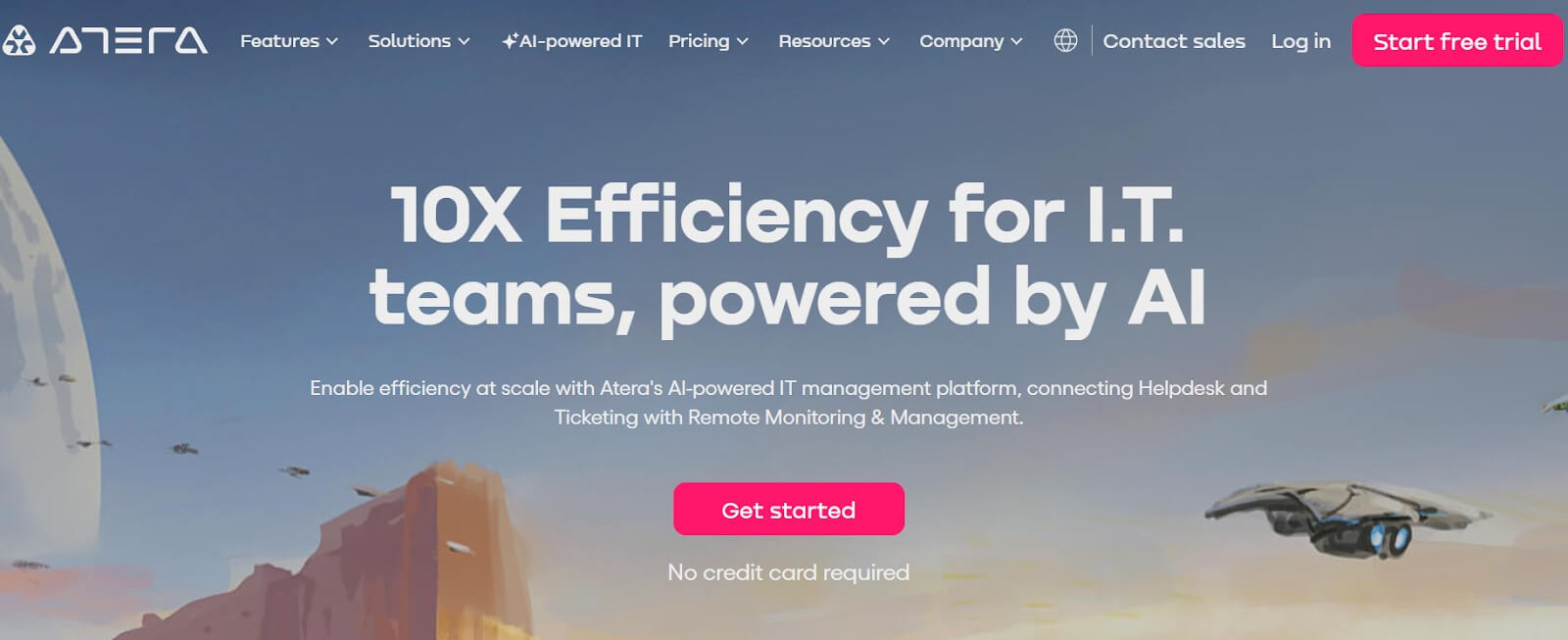
Atera offers a platform enabling your IT team to access, monitor, and manage networks and devices from any location. It combines patch management, automation, reporting, helpdesk, and integration with other tools into a single interface, streamlining IT management tasks and boosting productivity.
Atera’s real-time remote monitoring and scalable management capabilities ensure proactive oversight of users, devices, and sites, supported by automated alerts and customizable thresholds tailored to device types and user preferences.
Features:
- Automation: Quickly and easily automates most administrative and maintenance tasks, such as system scanning, update checks, and system reboots, to improve operational efficiency.
- Cross-Platform Compatibility: Works with Windows, macOS, Linux, and SNMP devices, ensuring versatility across different operating environments.
- Granular Patch Management: Allows admins to automate patch management at a granular level, applying settings to individual devices and device groups directly from the management console.
- Real-Time Monitoring and Alerts: Monitors client systems in real-time, providing IT admins with alerts about potential problems before they occur, allowing for preemptive action.
- Centralized AI: Enhances the RMM process by centralizing AI within the platform, including automated ticket summaries for streamlined workflows, actionable intelligence, and swift issue resolution.
Pros:
- advanced reporting
- robust ticketing system
- remote access for technicians
Cons:
- Limited customization options restrict the ability to tailor the platform to specific needs.
- The password manager functionality falls short of expectations.
- Features like dark mode limit flexibility and user preferences.
As a seasoned IT professional, I’ve tried numerous IT management platforms over the years, but none have impressed me quite like Atera. From its intuitive interface to its robust feature set, Atera has truly revolutionized the way I manage my clients’ IT infrastructure. As an IT professional, establishing a seamless initial connection with a new client is crucial for building trust and delivering efficient support. Unfortunately, the one-time connection feature in Atera has been a source of frustration and headaches.
G2 Review of Atera
3. Action1
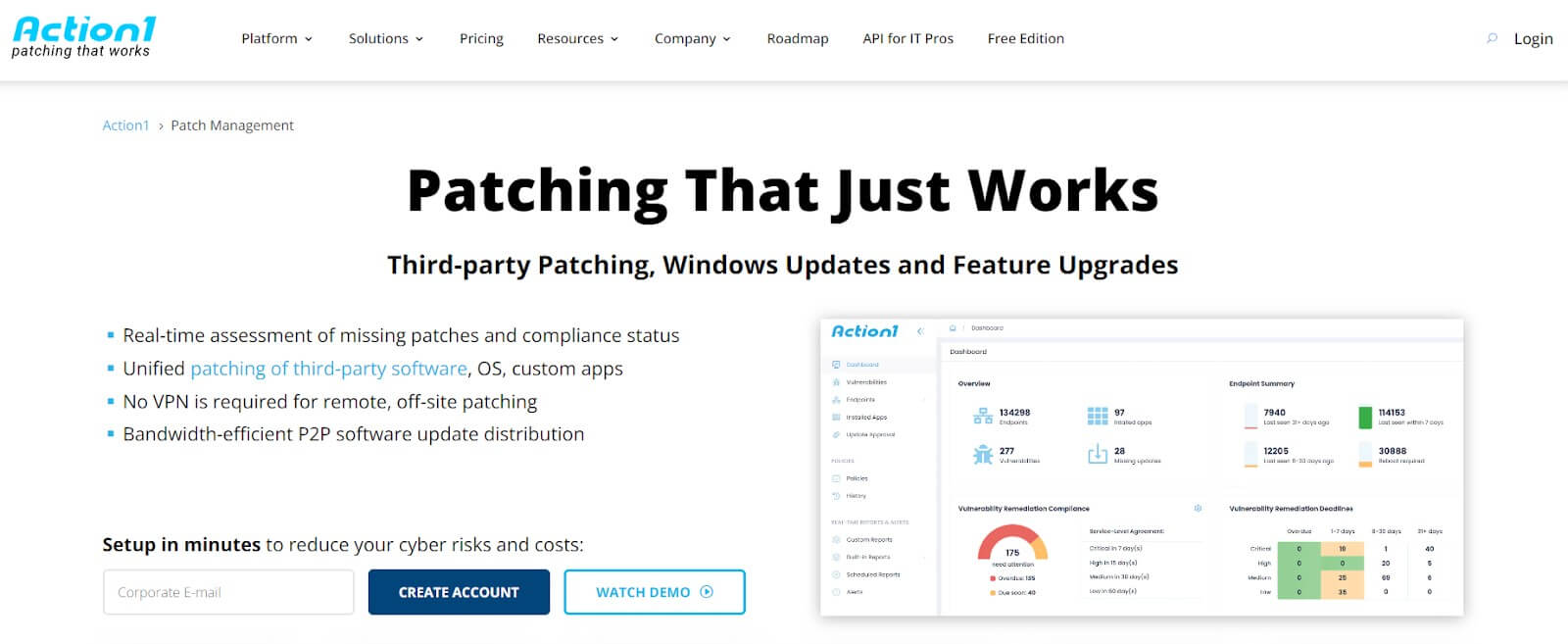
Action1, one of the NinjaOne alternatives, is a patch management platform that helps enterprises identify and address security vulnerabilities. Designed specifically for robust patch management, it serves as a strong alternative to NinjaOne for those in need of such capabilities.
However, its exclusive focus on patch management means it lacks some essential features, such as a built-in PSA system, which IT teams might require. If this is a concern, you may want to consider other alternatives.
Features:
- Patch Management: Action1 RMM simplifies patch management, ensuring endpoint protection from vulnerabilities. It includes a security feature that allows users to delay patch deployment for verification, providing time to address potential issues.
- Endpoint Monitoring: Provides real-time monitoring for endpoints, including servers and workstations. This ensures early issue detection and facilitates proactive problem resolution.
- Automation: Streamlines routine IT tasks through automation, reducing manual efforts and enhancing efficiency. Tasks such as software updates, maintenance, and reporting can be scheduled and automated, minimizing disruptions to endpoint users.
- Software Deployment: Simplifies remote software installations and updates for individual endpoints or groups. Its app store offers a wide array of common software, with the flexibility to add proprietary software as well.
Pros:
- Cloud-based structure is tailored for efficient management of remote workforces.
- Extensive multi-platform support accommodates diverse operating systems.
Cons:
- Minimum seat requirements may not align with the needs of smaller organizations.
- Teams new to patch management processes might face a learning curve.
- Feature set is limited compared to some enterprise-level solutions.
It is an easy-to-use tool for managing a large amount of equipment. We use it for hardware that is often located in temporary locations. This is also where the Powershell comes in very handy for rolling out changes. Furthermore, all our office equipment is also in the system for easy management and updating remotely. It should be nice when we also can manage iOS and Android devices. Then it’s really an all-in-one solution.
G2 Review of Action1
4. Kaseya VSA

Kaseya VSA simplifies various IT operations, including complaint handling, ticket management, audits, performance monitoring, and reporting.
It employs a pricing structure similar to NinjaOne, requiring a demo request to obtain pricing details. If transparent pricing is essential for you, considering an alternative like Heimdal might be a better option.
Features:
- Automation: Kaseya VSA automates endpoint protection with FireEye Operations Centre, Managed SOC, and Advanced Web Application Firewall capabilities. It includes proactive IT incident resolution, automated software deployment, patch management, antivirus/antimalware deployment, and routine maintenance. Policy-based automation ensures standardized processes with scheduled inventory scanning and patching.
- Remote Management: It offers Remote Control for direct endpoint console access and Live Connect for seamless issue resolution without user disruption.
- Patch and Software Management: IT admins centrally manage Windows and macOS software, automate patch management, and maintain transparency with patch history review and override options.
- Backup and Recovery: Ensures secure connections with a fully encrypted agent on a single outbound port. It integrates with leading antivirus/antimalware tools and Kaseya Unified Backup for comprehensive disaster recovery and data recoverability.
Pros:
- The software offers a network topology map for users to discover and monitor assets while observing endpoint connectivity.
- Administrators can automate IT processes like software patch management and incident auto-remediation.
Cons:
- Certain users find the interface cumbersome.
- Others encounter issues with the software’s ticketing system.
I love the connectivity and level of monitoring they provide. It is unique in the way that it monitors and gives you a simple dashboard summary. The fact that the product is inflexible with licensing. When you purchase a license for a site you have to continue paying for the license even when it is not being used. i.e if a 200 user site moves to another supplier you can not remove the licenses and have to pay for them anyway or until you get another site signed up. Makes the product very costly.
G2 Review of Kaseya VSA
5. ConnectWise Automate
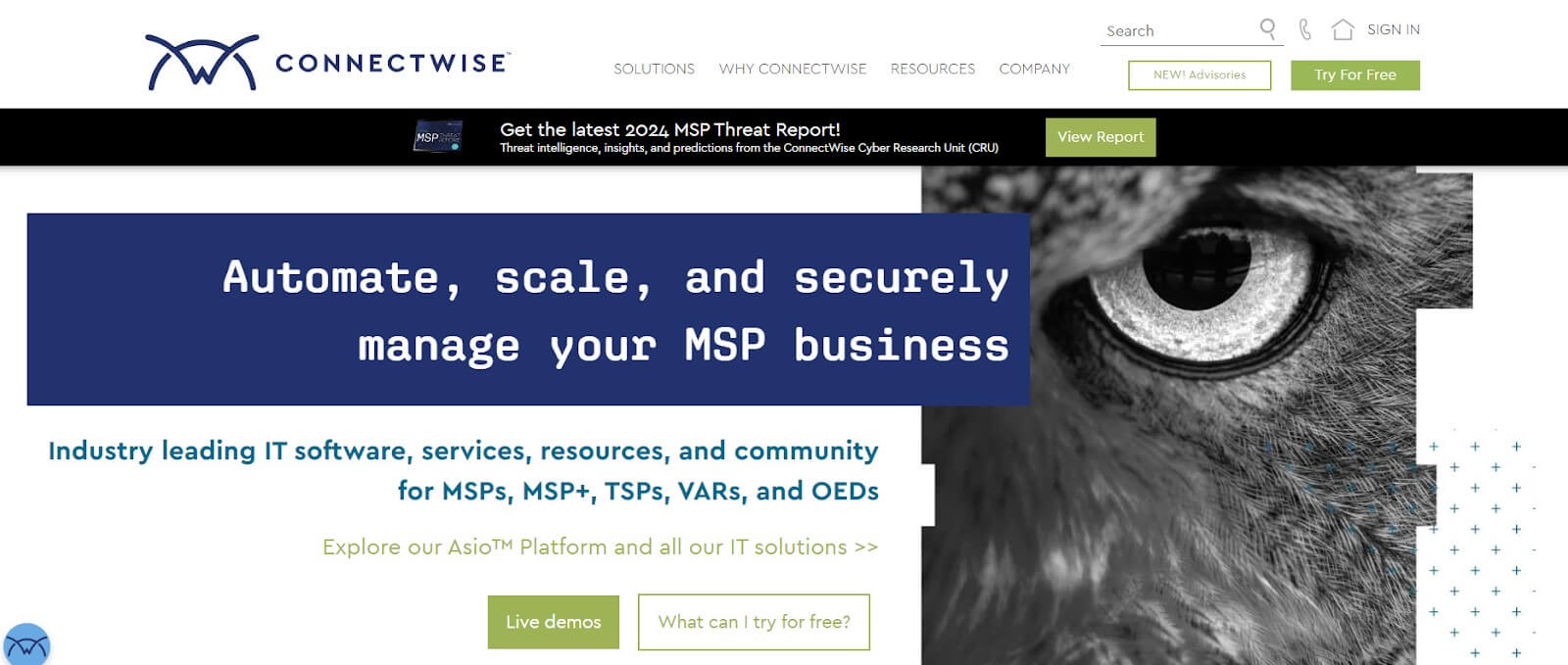
ConnectWise offers software solutions tailored for technology solution providers (TSPs), including ConnectWise Automate, formerly known as Labtech.
This platform enables organizations to deliver proactive support and system monitoring through advanced automation. It helps IT teams save time, enhance customer experience, and gain deep insights into technology performance, supporting scalable growth and operational efficiency.
Features:
- Patch Management: ConnectWise Automate automates roll-outs and maintenance tasks for Windows and third-party software, reducing costs and saving time.
- Monitoring and Reporting Tools: It provides robust tools for remote control session auditing, agent and agentless device management, and technology status analyses, acting as a single source of truth.
- Asset Discovery: The asset discovery feature automatically detects devices on client networks for quick management and enhanced accountability, helping to minimize downtime during IT issue resolution.
- Remote Session Capabilities: Admins can access and support their customers from any location at any time, ensuring continuous service and rapid response.
Pros:
- IT teams benefit from extensive customizations that enable them to effectively meet their clients’ needs.
- Progressive workflow efficiency is achieved through intelligent automations.
Cons:
- When compared to some alternatives, ConnectWise Automate has limited third-party integrations.
- The pricing model lacks transparency.
I like the full view you can get into endpoint machines. The reporting is comprehensive and generally useful. The 2FA is a much needed upgrade, so nice job CW. The desktop version is very slow and can bog down my machine quickly. The web version has about 1/4 the functionality of the desktop app. Reports are clunky and hard to refine for usefulness. A lot of unneeded white space really racks up the page count.
G2 Review of ConnectWise Automate
6. N-sight

N-able N-sight RMM, one of the NinjaOne alternatives integrates remote monitoring and management, remote access, ticketing, and billing into a single, powerful, and user-friendly platform.
This solution streamlines daily operations, enhances threat defense, and boosts operational efficiency.
Features:
- Automation: Automation within the platform ensures scalability, making it suitable for even the largest or most complex clients.
- Security and Management Tools: Integrated features include antivirus, patch management, web protection, backup, endpoint detection and response, and risk intelligence data security assessments.
- Remote Control: Remote control capabilities allow users to identify and resolve any issue on any endpoint from anywhere, without disrupting the end user.
- Integrated Service Desk: The platform includes an integrated service desk for creating tickets, customizing billing, and managing an IT services business.
- Reporting: Built-in reporting features enable users to demonstrate value to their clients effectively.
Pros:
- Fast and reliable remote connection.
- Excellent remote background features.
- Lightweight product that does not slow down end-user machines.
Cons:
- Some minor bugs need to be resolved.
- macOS functionality is not as strong as that for Windows.
- Occasional unexplained installer failures.
Integration with third party tools (especially AV Defender) is terrible. Support is lukewarm on the best of days unless you get management involved and even then…you’re likely to leave unsatisfied. Management doesn’t want to tell the technical people their answers don’t make sense and the technical people are happy to take advantage of that weakness in management.
G2 Review of N-sight
7. ManageEngine Endpoint Central
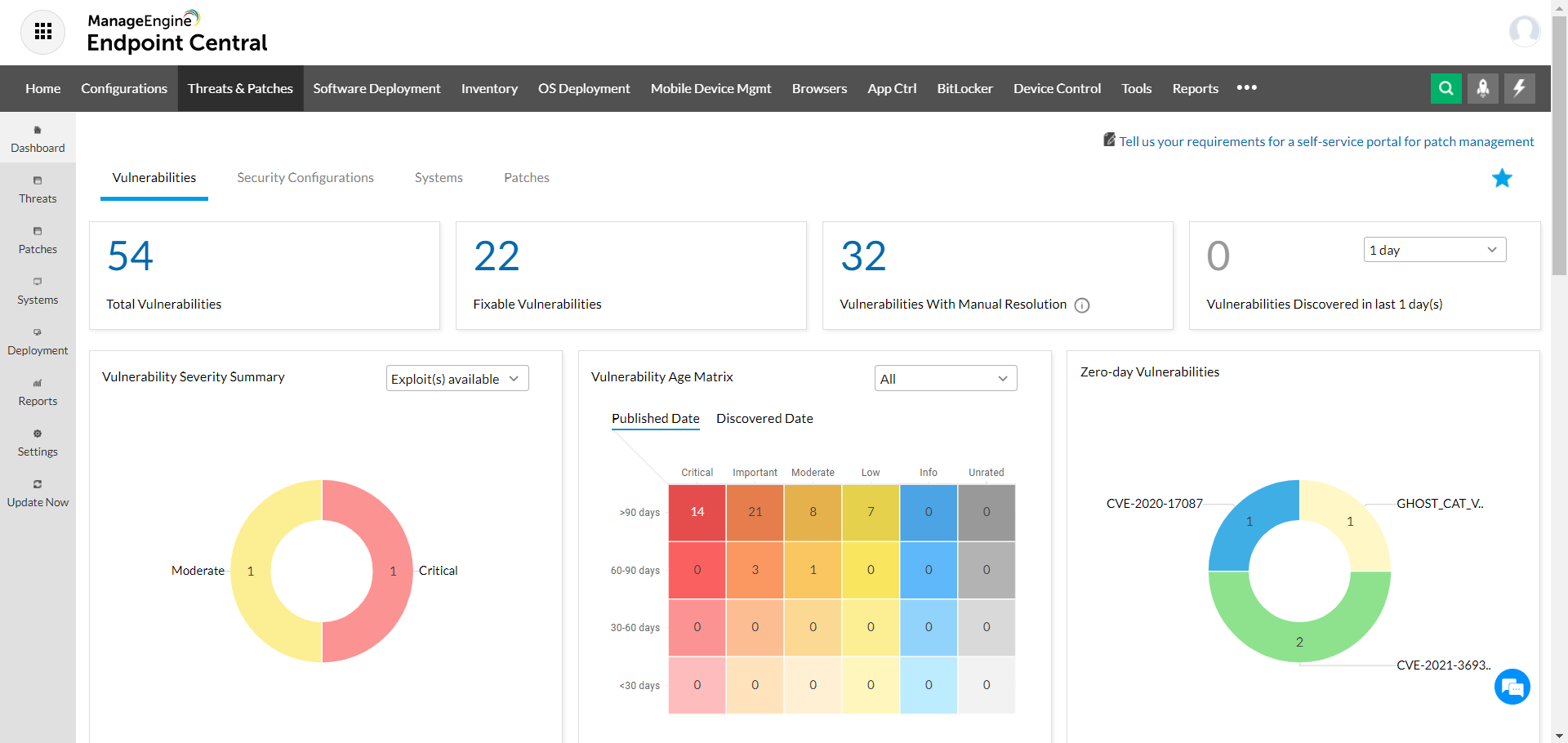
ManageEngine Endpoint Central empowers IT organizations to establish secure remote work environments by facilitating seamless access to resources from any device. It incorporates application-level controls and intent-based policies to enhance security.
Supporting diverse BYOD ecosystems, Endpoint Central offers easy management of all endpoints, whether on-premises or remote, including desktops and mobile devices. The platform also facilitates remote device deployment while maintaining rigorous security standards.
Features:
- Patch Management: Automates the installation of patches and updates across all supported devices, ensuring they are up-to-date and secure.
- Vulnerability Detection: Detects vulnerabilities on endpoints and takes proactive measures to mitigate risks.
- Software Deployment: Facilitates deployment of software applications to endpoints, ensuring uniformity and efficiency.
- OS Imaging and Deployment: Simplifies imaging and deployment of operating systems to streamline device setup and management.
- Mobile Device Management (MDM): Manages mobile and BYOD devices by deploying profiles and policies, configuring Wi-Fi, VPN, and email settings, and applying restrictions on device features like camera usage and web browsing.
- Security Management: Enhances device security with features such as enabling passcodes, remote lock or wipe capabilities, ensuring data protection in case of device loss or theft.
Pros:
- Facilitates task and project organization, tracking, and automation, ensuring efficient allocation and proactive monitoring of progress.
- Provides robust reporting tools for comprehensive analysis of ticket data, supporting informed decision-making and performance evaluation.
Cons:
- Occasional crashes may impact software reliability and productivity.
- Infrequent updates may lead to missing out on new features, performance improvements, and security patches.
- Outdated or inaccurate documentation can cause confusion and inefficiencies in software usage and troubleshooting.
We stopped using the patch management piece as it was cumbersome to use at times. We instead rely on Intune and PatchMyPC. The MDM solution is also lacking in comparison to Intune, so we have that feature disabled. One thing that is also lacking is the Remote Control feature for machines. I’d like to see that become comparable to something like Teamviewer. Performing updates to these products (we run on-prem) has been extremely painful at times. I would highly recommend going with the cloud version of all their products.
G2 Review of ManageEngine Endpoint Central
8. Datto RMM

Datto RMM is a cloud-based solution designed for remote endpoint management, enhancing network efficiency and cost reduction through remote security, monitoring, and management capabilities.
The platform offers dashboards for instant data assessment and analysis, along with automation features such as intelligent alerts and auto-resolution to streamline IT procedures.
With a security-first approach, Datto RMM ensures comprehensive endpoint and data security, incorporating features like native ransomware detection and two-factor authentication.
Features:
- Auto-Response to Alerts: Provides IT technicians with essential diagnostic data for simplified troubleshooting and instant problem resolution.
- Real-Time Monitoring: Ensures optimal performance of security tools and enables proactive issue resolution.
- Reporting: Admins can access on-demand and scheduled reports on clients’ system health, facilitating prompt action when needed
- Patch Management: Admins automate patching for Windows, MacOS, and Linux devices, including third-party applications through Datto’s Chocolatey integration. Configurable and automatable policies save time and enhance client security against the latest threats.
Pros:
- Offers a reliable backup solution with automated backups, file/volume/server recovery, and offsite backups for robust data protection.
- Features a simple deployment process and user-friendly interface that facilitates easy device management.
Cons:
- Implementation of necessary changes may occasionally result in longer-than-desired timelines, affecting user experience and workflow efficiency.
- Technical support consistency and responsiveness can vary, leading to frustrations in issue resolution.
- Pricing complexity and potential high costs, particularly challenging for smaller businesses, with occasional unexpected offline incidents reported.
The ability to change the appearance to your taste is also great for productivity and the ease of generating reports is also a worthwhile feature. The new UI doesn’t allow you to generate a list when searching which is quite annoying as we support quite a lot of users and having the search show within a table is very useful to finding specific people when they’re unaware of their device name etc.
G2 Review of Datto RMM
9. GoTo Resolve
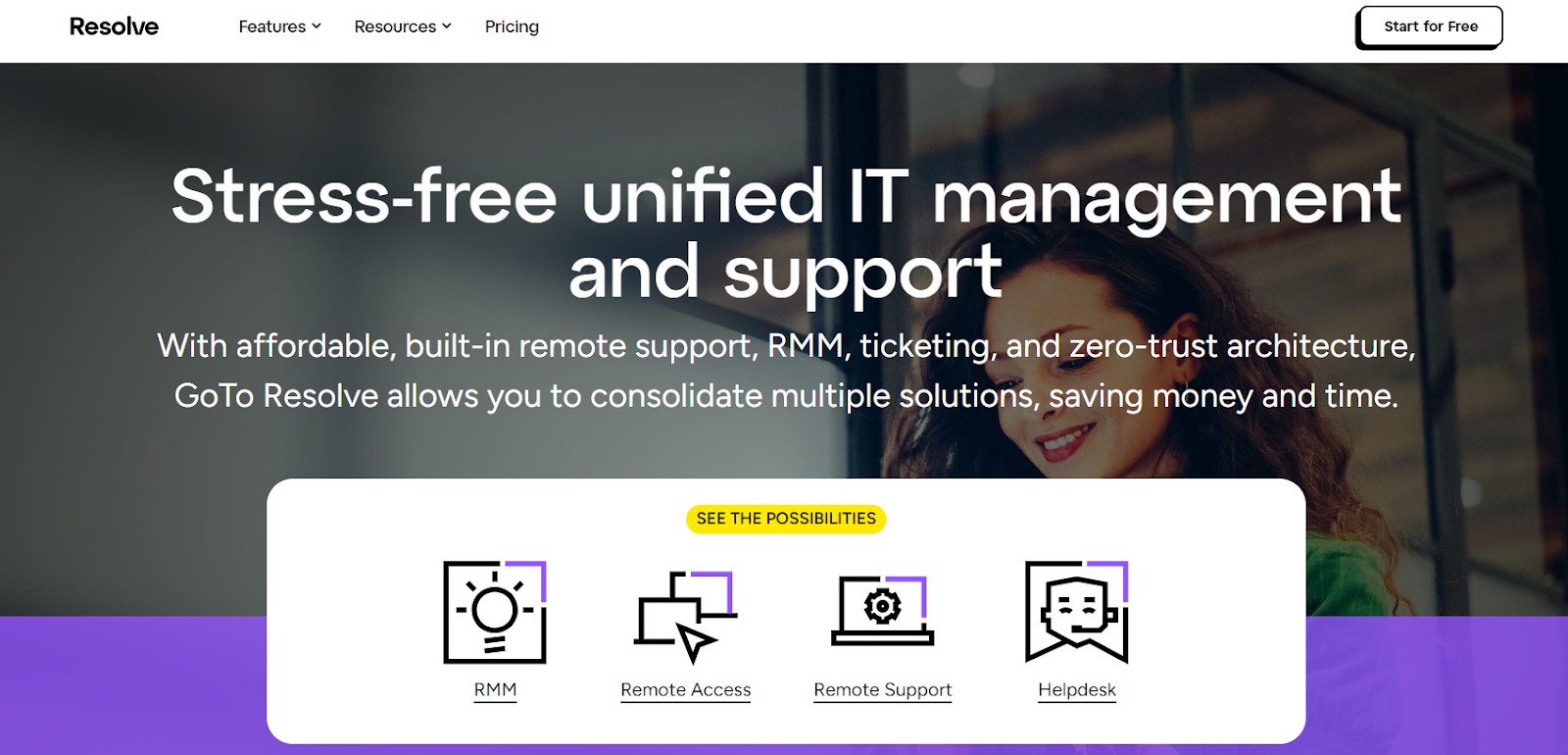
Formerly branded as GoToAssist, GoTo Resolve now serves as a cloud-based software solution tailored for IT firms.
It offers a streamlined platform with various integrations, such as remote computer monitoring, ticketing alerts, automated workstations, and mobile device management.
However, GoTo Resolve falls short in comparison to other management software mentioned here.
Its feature set is somewhat limited, which may not meet the needs of users requiring a robust ticketing system, comprehensive reporting capabilities, and extensive patch management.
Features:
- Patch Management: GoTo Resolve centrally manages and deploys software patches and updates, ensuring systems are secure and up-to-date.
- Customizable Alerting: Allows setting up alerts for specific events or thresholds, enabling prompt responses to critical issues.
- IT Automation: Streamlines repetitive tasks like software deployment and maintenance, enhancing operational efficiency.
- Antivirus Management: Centrally manages antivirus protection on devices to safeguard against malware and viruses.
- Background Access: Provides remote access for troubleshooting without disrupting end users, facilitating efficient support and maintenance.
Pros:
- The service is cost-effective.
- It includes robust tools for live support.
Cons:
- A dedicated mobile application is not available.
- Remote session performance may occasionally suffer from sluggish speed.
The ease of use and the ability to connect with clients to assist with their needs. Users can easily connect using a variety of technology, from desktops, and laptops, to android phones. Users will occasionally run into lag time, and clients who have not educated themselves about the product may run into problems using the software. It is a bit pricey compared to similar products.
G2 Review of GoTo Resolve
10. Pulseway
Pulseway is an IT monitoring and management solution that allows users to oversee, manage, and control all systems and servers directly from their smartphone, tablet, or web browser. It sends instant notifications to system administrators, enabling them to quickly identify and resolve issues within seconds.
As a NinjaOne alternative, Pulseway provides System Administrators and IT teams with a unified view of their entire IT environment, allowing them to stay informed about activities at any moment. The software is scalable, accommodating businesses of all sizes and supporting their growth aspirations.
Features:
- Automation: Auto-remediation workflows ensure that IT issues are resolved proactively, preempting user awareness of problems.
- Mobile Access: Customers can oversee, manage, connect with, and troubleshoot devices directly from their mobile devices. They can also update tickets swiftly, enabling rapid responses to issues.
- Remote Control: Pulseway’s exclusive remote control feature allows connections to monitored endpoints or network devices. Moreover, users can remotely access applications and files, transfer files to and from endpoints, and engage in real-time chats.
- Patch Management: It patches applications across all devices and updates Windows systems and servers seamlessly from any location.
- Network Monitoring: Pulseway Network Monitoring provides comprehensive network visibility by converting Pulseway agents into probes and incorporating all discovered devices into monitoring.
Pros:
- Monitors computers and alerts for any issues.
- Enables remote control of computers, including initiating reboots.
Cons:
- No network mapping option available.
- Clients on Windows Server occasionally experience breakdowns.
Despite being a good idea the fact that you can have a single probe in your network proxing installation of the agent for others is NOT very effective. Also the network monitor part is not very complete and major MIB for the SNMP part have been promised for a long time but still are not present.
G2 Review of Pulseway
NinjaOne Break Down
NinjaOne, formerly known as NinjaRMM, is a comprehensive IT management platform designed to streamline the management and security of organizational endpoints for MSPs and IT professionals.
This unified solution supports various devices, including Windows, Mac, and Linux-based systems, whether physical or virtual.
Key Features
- Remote Monitoring and Management: Provides a consolidated view into the health and status of all endpoints, allowing IT teams to monitor and manage devices efficiently.
- Remote Access: Facilitates remote control of devices, enabling tasks such as initiating reboots and performing maintenance without disrupting the end user.
- Automation: Includes extensive automation capabilities with out-of-box platform policies and a library of hundreds of scripts, allowing for the automation of virtually any action or alert response.
- Security and Patching: Empowers IT teams with fundamental cyber hygiene tools, such as timely patching, endpoint hardening, antivirus deployment, consistent backups, and clear visibility into the health and training support, enabling customers to get started in days rather than weeks or months. Technicians can quickly become productive, effectively monitoring, patching, securing, and remotely supporting end users.
Pros
- Reduces time for daily endpoint management and security tasks.
- Automation enables handling more endpoints per technician.
- Proactively resolves issues, minimizing end-user disruptions.
- Highly responsive platform that executes tasks and scripts quickly.
- High customer satisfaction with fast ticket response times.
- Offers month-to-month pricing with no additional cost for training and support.
- Regular updates based on customer feedback and requests.
But wait!
If there are so many benefits of NinjaOne, then why are people considering its alternatives?
It’s because it has a lot of drawbacks too.
Reasons for NinjaOne Alternatives
Despite its many strengths, NinjaOne does have some drawbacks that users should be aware of:
- Limited Mobile Functionality: NinjaOne’s capabilities for managing mobile devices, such as Android and Apple tablets, are limited.
- High Costs: The cost of using NinjaOne can be relatively high, particularly for smaller organizations or those with tight budgets.
- Lack of Built-In PSA System: NinjaOne does not include a built-in Professional Services Automation (PSA) system.
- Limited Integration Capabilities: While NinjaOne integrates with several key tools, there are limitations.
- Complexity: Some users find NinjaOne complex to set up and configure, particularly if they require advanced customization or are less familiar with IT management platforms.
- Scripting Enhancements Needed: The scripting feature could benefit from enhanced functionality and better variable usage, which would allow for more sophisticated automation tasks.
- Customization of Reporting: The reporting options available in NinjaOne lack the desired level of customization, limiting users’ ability to tailor reports to specific needs and metrics.
- Software Deployment Process: Deploying software through NinjaOne could be more user-friendly.
- Event Log Filterability: Endpoint event logs are often lean and lack adequate filterability, making it difficult for users to sift through and analyze logs effectively.
- Installer Issues: There are occasional unexplained failures during the installation process, which is frustrating and time-consuming to troubleshoot.
- macOS Support: The support for macOS within NinjaOne is not as robust as it is for Windows, which is a limitation for organizations with a significant number of Mac devices.
- Network Mapping Capabilities: NinjaOne lacks built-in network mapping capabilities, which is a disadvantage for users who need a visual representation of their network infrastructure.
Here’s what professionals are saying about NinjaOne on Reddit:
We are using NinjaOne RMM, and it barely works. Patches often fail, the Remote tool is inconsistent at best, the patches that do work are very often very late, there is a big lack of granularity in tasks and reporting. Overall, we’re not happy, and are looking at switching providers.
We used them for years, and then they kept increasing their pricing. They claimed not to have any contracts, but it is a lie. When we tried to cancel, they said we had to give them months’ notice, then lower it to a certain amount, and it was a whole ordeal that appeared very deceptive in the end.
How to Choose the Right NinjaOne Alternative for Your Company
Before you build your own cybersecurity solutions shortlist to replace NinjaOne, let’s do a quick run through the key factors to consider before you make a choice.
Is your company fostering a remote or hybrid work environment? Does it run offices in various locations worldwide? Then you’ll need a tool that offers remote management capabilities and remote troubleshooting.
Is your system running on more than one operating system? Then a cross-platform tool, that automates patch management and streamlines processes across Windows, Linux and macOS alike is what you need.
Small businesses that try to keep a secure environment but only have a small IT team to run operations should consider a solution that can automate repetitive tasks.
So, choose a solution that responds to your specific needs and that will support the security measures in your defense strategy.
1. Assess Your Specific Needs and Priorities
- Identify the key features your organization requires.
- Prioritize functionalities such as remote management, automation, and continuous device monitoring.
- Ensure the solution aligns with your operational goals and IT management strategies.
2. Evaluate Integration Capabilities
- Check if the alternative integrates seamlessly with your existing tools and systems.
- Look for compatibility with PSAs, EDR tools, notification platforms, and remote access solutions.
- Ensure integration will not disrupt your current workflows.
3. Pricing and Scalability
- Compare pricing models to find an option that fits your budget.
- Consider the scalability of the solution to ensure it can grow with your business.
- Evaluate whether the cost is justified by the features and benefits provided.
4. Asses User Friendliness and Ease of Use
- Choose a platform with an intuitive interface and easy setup process.
- Ensure that the learning curve is manageable for your team.
- Look for features that simplify day-to-day operations and reduce administrative burden.
5. Test Customer Support and Reliability
- Investigate the quality of customer support offered by the provider.
- Look for responsive, 24/7 support options.
- Check reviews and testimonials to gauge the reliability and effectiveness of the support team.
Frequently Asked Questions (FAQs)
What type of program is NinjaOne?
NinjaOne offers comprehensive IT management software integrating robust monitoring, management, patching, backup, and automation capabilities, all enhanced by a sleek, modern UI. This combination enhances technician efficiency and elevates IT service delivery standards.
What devices are supported by NinjaOne?
The supported operating systems encompass Mac, Windows, and Linux. Moreover, the NinjaOne mobile app is accessible on Android, iOS, and iPadOS platforms.










 Network Security
Network Security
 Vulnerability Management
Vulnerability Management
 Privileged Access Management
Privileged Access Management  Endpoint Security
Endpoint Security
 Threat Hunting
Threat Hunting
 Unified Endpoint Management
Unified Endpoint Management
 Email & Collaboration Security
Email & Collaboration Security



